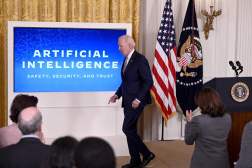White House: Competitions and challenges growing in use, sophistication
In the coming years, more agencies will likely create increasingly ambitious and sophisticated prize competitions and challenges that leverage partnerships, a White House report published Wednesday predicts.
The White House Office of Science and Technology Policy’s report analyzed public-sector prize competitions and challenges, and found that in fiscal year 2015, the public sector was using prize competitions and challenges more often, and using partnerships to make them more ambitious.
More competitions and challenges in 2015 were also focused on technology development, the report found. Of the 116 prize competitions agencies conducted in fiscal 2015, half of those listed “develop technology” as one of their goals, a 23 percent increase from the year before.
The report — which OSTP is providing to the House Committee on Science, Space, and Technology and the Senate Committee on Commerce, Science, and Transportation — comes after the Senate committee approved legislation this summer that would work to spur science and technology research and development, and would reaffirm agencies’ authority to conduct prize challenges.
[Read more: Senate Commerce Committee approves technology research policy bill]
In fiscal 2015, partnerships enabled more ambitious prize designs, the report notes, but it added that the government could still work to expand overall level of ambition in competitions. The report provided several examples of “ambitious projects,” including competitions held by the National Institute of Standards and Technology, and NASA.
“Partnerships with other Federal agencies, not for-profit and for-profit entities allow agencies to be more ambitious in designing and executing challenges because partners are able to provide additional resources and perspectives,” the report says.
The NIST Head Health Challenge III, one of the examples listed, is a challenge to develop materials with good energy absorption and energy dissipation. NIST partnered with the National Football League, Under Armour and General Electric, offering up to $2 million in prizes. Five teams have been selected as first round awardees, and early next year, the judges will select a winner for the grand prize.
The challenge “is quite ambitious in that it relies on multiple partnerships, provides testing for a technology development challenge and involves NIST in a complex judging process,” the report says.
NASA’s Cube Quest Challenge, another example, has a total of $5.5 million in prize money. The overall goal is to “develop and test subsystems necessary to perform deep-space exploration using small spacecraft,” according to the report. Selected teams will launch as a secondary payload on the Space Launch System rocket.
“This incentive is the first time NASA has offered a ride on a rocket through a prize, which shows a more serious use of prizes for in-space technology demonstration,” the report notes of the challenge, in which NASA’s Ames Research Center is partnering with San Jose State University.
Registration for the challenge began in 2014, and the challenge is expected to run for four years.
[Read more: NASA to launch small satellites on future Mars rocket ship]
The report also noted that some competitions used new ways to engage the public, including:
- Soliciting comment on draft rules;
- Running pilot challenges to get feedback;
- Publishing winning resources as open source;
- Using crowdfunding to support participants; and
- Asking winners to create webinars on their solutions.
Overall, challenges and prize competitions have unique benefits, the report notes.
“As Federal employees extend the use of leading innovation techniques such as prizes and challenges, our public sector workforce will be better equipped tackle intractable problems like climate change and infectious diseases, while making meaningful advancements in scientific research, technological development, educational attainment, and economic prosperity,” the report summary says.






